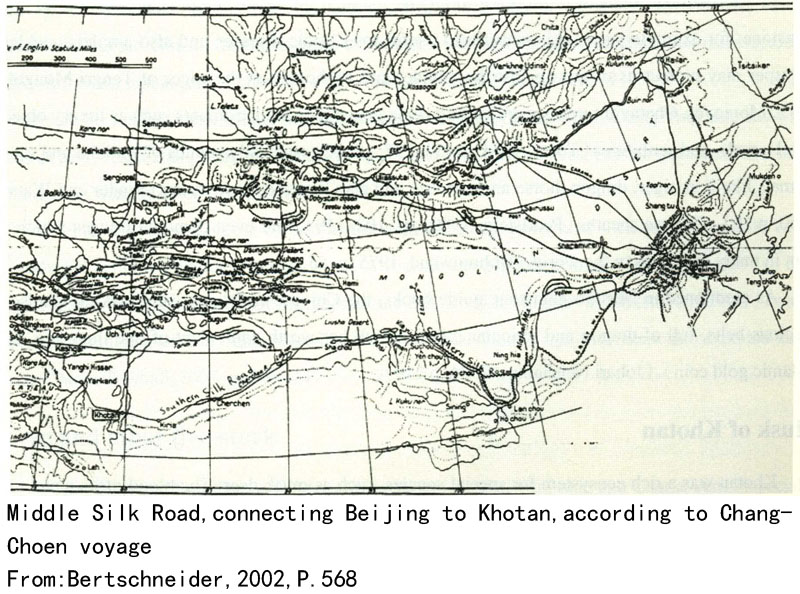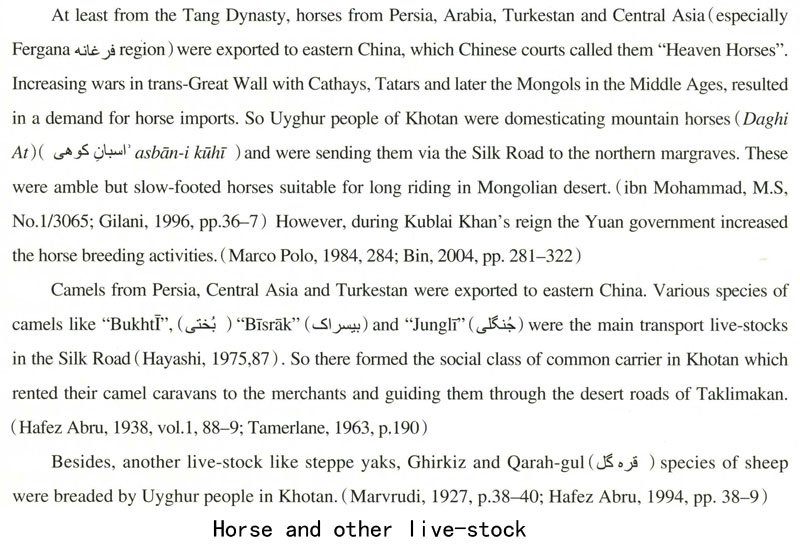The Role of Khotan Region in the Economy of Middle Silk Road(Focusing on the 13—14th centuries)
Ali Bahranipour(Ph.D)
Assistant professor of History,Shahid Chamran University
Middle Silk Road,connecting Beijing to Khotan,according to Chang-Choen voyage
From:Bertschneider,2002,P.568
The influence of local products and commodities in the flourishing situation of Khotan on the Southern Silk Road
Jasper and Jade
In the Chinese sources from the late Han dynasty,Khotan region named Yu-tien(Mountain of Jade);because in that territory,there were two rivers north-south flowing:Po-Yu-Ho(the river of white Jade stones)in the east,and Lu-Yu-Ho(the river of green Jade stones).A northern spot where these two branches were divided from the upper main river was called Hey-Yu-Ho(the river of black Jade stone).(Yeluchutsai in Bertschneider,2002,p.46).These rivers were originated from Kunlun(Qara-qum)Mountains and Tarim River(Al-Hamavi,vo1.2,p.215).Passing under the rock quarries,these streams have brought Jade stones of various colors(Biruni,1995,p.317)such as:green(jadeite)emerald-like as its favorite type in the west(Odoric,op.cit,vol.2,p.207,221),white(jasper)as the treasured gemstone in China,yellow(heliotrope),black and gray.Sometimes they discolored to yellow and black pigments.(Toosi,1984,pp.59,197,121-2).It seems that,jade and jasper were sent to Beijing in raw rubble pieces.As a rule,the big valuable pieces shall be presented by local authorities to the Great Khan(the emperor),the others were been sold.(Ming-shih in Bertschneider,2002,p.487)
So the Yuan government had appointed officers to direct jade extraction activities on these rivers,but some moonshiners have dove and seeking the jade pieces via its phosphoric refulgence,and have sold them to the merchants of the Silk Road by good prices.(Marco Polo,1984,p.284).
In 12th century,there was a belief about the medical and even magical properties for some gemstone;for example jasper was considered useful for Castaic diseases and also amulets necklaces of jasper may protect its owner against the thunder and flashover(as the anger of Tengri Mongolian god).Moreover,Chatayid turners were cutting these gemstones to instruments such as luxury objects,jewels,seals,and sculptures(Toosi,1984,pp.59,197,121-2)especially statues of Buddha and sacred animals like lion,tiger,dragon,horse and tortoise,and also inscribed jade dishes(Pinder and Watson,1960,p.19),Chinese sheaths(Pearlstein,1990,pp.102-119),and even demonic Images which are kept in many museums in the world.(Dohrenwend,1975,p.55).
As mentioned in Muslim gemstone guide books,the Chinese craftsmen were making handsome precious belts,full of dragon and reticular reliefs which per worth equivalent of one thousand dinar(Islamic gold coin).(Johari Neishaburi,2004,p.219).
Musk of Khotan
Khotan was a rich ecosystem for special species,such as musk deer.The blood of its navel after being dried,musk deers were scraped and peeling it on the bushes.As a result,gathering the dried navels or hunting the deers made a beneficial income for local hunters(Bakran,102-3;Ming-shih,2002,465-7).Chinese and European travelers and Muslim geographers considered the musk of Khotan as the best among the same production of other areas which in sequence were:Tibet,Tatar,Cathay(Chang-Choen,in Bertschneider,2002,71),Qirqiz,Kashmir,and lastly Ceylon(de Cora,Yule,1998,vol.2,pp.31,11).Every navel of musk deer of Khotan had seventy five gram of valuable musk(Rashid al-din,Asar va Rhya,pp.102-3,248-9,250-53).
Frequent references to musk of Khotan in Persian literature,especially during Mongol era,indicate the increase in importance and volume of musk trade.It seems that also,musk of Khotan was a recognized product which enjoyed huge demand in the Muslim royal courts and all around the world.One can say the geographical situation of Khotan on the Silk Road brought an international commercial significance as well as a demand for musk of Khotan;but it is more logical argumentation that:the high grade valuable musk and its beneficial trade absorbed the caravans,and became one of the reasons for the veering and formation of southern Silk Road via the troublesome way of Taklimakan to Khotan.
Khotan:Textile production and transportation of Chinese manufactures
From the ancient times,there was a commercial route between Turkestan(Sin-kiang)and India which had a connection with the Southern Silk Road(Rawlinson,1868—1869,p.10).India in cotton textile and China by its famous Silk industry were the greatest international hubs for textile industry and trade.Khotan also had good desert climate for cotton fields as well as it was influenced by Indian cotton manufacturing;moreover it was a transit center for Indian cotton to eastern China(Dale,2009,79)
Beside the textiles,other Chines products such as chinaware(celadon and Ching-Ting blue and white ceramics etc),Khan-Baliq paper and painted objects,and also Indian spices,Persian gemstones like lazuli and turquoise were transited from Khotan.
Porcelain conveyed Chinese culture across vast distances,penetrated societies in manifold ways,and reshaped ceramic traditions throughout the Afro-Eurasian acumen(Finlay,1998,pp.14-187)so that,because of the flourishing porcelain trade across the Silk Road in Seljuk to Ilkhanid dynasties,Iranian kilns were producing crockery chinaware-like namely“Badal-Chini”(**),and also exported lazuli tales to China(Towhidi,2007,pp.270-74).
Slaves and bond women trade and transit in Khotan
From the 10th century,when Qara-Khanid sultanate developed in Turkestan,Turk slaves were bought and employed in the Muslim cavalry such as Caliphate and Persian armies,and also pretty bond women were employed in noblesse’s houses and cabarets.In some war eras like the Mongol conquests,slaves from various peoples and tribes like Turks,Hans,Khotani,Khwarazmish,Chagol,Yaghma,Kalakh,and even Kashmiri were exported via Khotan and other stations of the Silk Road to Iran and other bazaars in the Muslim World.As a result,the war flourished the slave trade,and increased the coercive migration of the work force and craftsmen(Ovoz)and troops,as it is deeply reflexed in the Persian literature.
Conclusion
Regarding the historic-archaeological documents,despite the prevalent opinion,Khotan was not only a midway oasis station on the Silk Road,but also the main source mine for Jade and jasper,an important farm for horse and camel,a terminal for transit and transportation for jade,pack animals,horses,Chinese silk and Indian cotton.The basis of economic life in Khotan was not absolutely depended just on the Silk Road transportation;but despite,it had such economic sources that it dragged a branch of the Silk Road for itself,regardless many great obstacle such as Taklimakan Desert.Even more one could regard Khotan city as a partly independent economic unit which was more an exporter market than to be an importer city.Maybe its economically substantive particularity caused the rise of wealthy sultanates such as Qara-Khan(10th century),Qara-Cathay(11—12th century)and Beig of in Khotan(15th century)and all-around Turkestan region.Anyway,because of the historical circumstances and its economic resources,Khotan was a turning-point in the Silk Road;as well as the main jetty for the southern Silk Road,and lastly Khotan was a mediator in the commercial and cultural relations between China and the Muslim world especially Iran.
Bibliography Persian
Mohammad ibn Abi-Tāleb Ansāri Al-Demashghi,Nokhbat al-Dahr fi‘Ajayeb al-Barre wa al-Bahr,translator:Hamid Tabibiān,Tehran:Asatir,1382.
Qadi Ahmad Tatawi and Asef Khan Qazvini,Tarikh-i Alji,editor: gholamreza Tabātbāie-majd,Tehran:Elmi va Farhangi,2003.
Marco Polo,Le livre de Marco Polo,Citoyen de Veniz,par Ructicien de Pise et M.G.Pauthier,premier partier,Paris:Librairie de firmin didot Freres,Fils et C Imprimeurs de l'Institute de France,1920.
Marvrudi.Fakhru'd-Din Mubarakshah (1206),Tarikh-I Fakhru;d-Din Mubabakshah,E.DenisonRoss,(London:the Royal Asiatic Society,1927).
Yang.Bin,Horses,Silver,and Cowries:Yunnan in Global Perspective,Journal of World History,Vol.15,No.3(Sep.,2004),pp.281-322
Finlay.Robert,The Pilgrim Art:The Culture of Porcelain in World History,Journal of World History,Vol.9,No.2(Fall,1998),pp.141-187
ibn Mohammad,M.S,No.1/3065
Al-Hamavi.Yaghut.
Towhidi,Faegh.2007.
Hayashi.Ryoichi,The Silk Road and the Shoso-in,Tokyo:Heibonsha,1975.
Ye-lo Chu-tsai“Si Yo Lo”in Emilie Vasil'esvich Bertschneider,Iran va Mavara-al-Nahr dar neveshte-haye Chini va Mogholi-e sadehaye mianeh:(Mediaeval researches from eastern Asiatic sources;fragments towards the knowledge of geography and history of central and western Asia from the 13th to the 17th century,translation to farsi:Hashem Rajabzade,Tehran:Bonyad-e Mowghufat-e Mahmud Afshar,2002.
Pinder.Ralph-Watson.Wilson and William,An Inscribed Jade Cup from Samarqand,The British Museum Quarterly,Vol.23,No.1(Sep.,1960),pp.19-22.
Pearlstein.Elinor L.,A Jade Sheath of Early Imperial China,Art Institute of Chicago Museum Studies,Vol.16,No.2(1990),pp.102-119,173-176.
Dohrenwend.Doris J.Jade Demonic Images from Early China,Arts Orientalis,Vol.10,(1975),pp.55-78 Chavannes,Documents sur Les Tou-kiue(Turcs)occidentaux,Librairie d’Amérique et d’Orient p.198.
Sylvai Levi et Edouard Chavannes,“voyages d’Ou-k’ong“,Journal Asiatique,Sept.-Oct.1895,pp.341-384.
Ndereh Badi’I,Dictionary of Persian loan-words in Uyghur language in China,Tehran:Bonyad-e Nishabur,1998,P.349.
Abstract
During the Mongol hegemony on Eurasia,the middle Silk Road was originated from Khan-Baligh(Daidu or Beijing),crossing Taklimakan Desert in western China,reached the oasis sub-mountainous region.Historical sources and itinerary books mentioned Khotan(Hotan)just as a station for the Silk Road and a Muslim(Ta-shi or Uyghur)society.But,regarding the mineral products and agricultural crops of Khotan region,it seems there was more that a station.So the question is:what was the role of Khotan region in the economy of middle Silk Road in 13—14th centuries?The hypothesis is:for caravans coming from Peking,Khotan was a preparatory station for water and provender and a bazaar for Chinese commodities,but for western(Persian,Uyghur and any other Muslim)merchants there was a source-place for buying Jasper and exporting it to eastern China.






